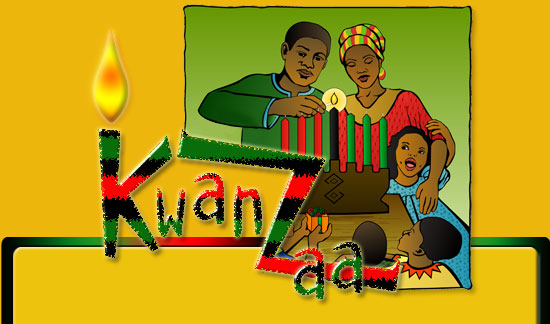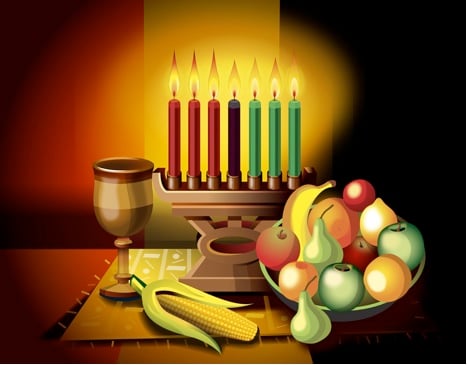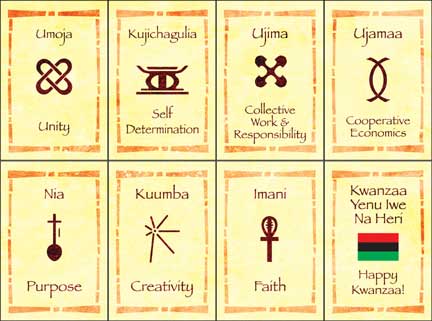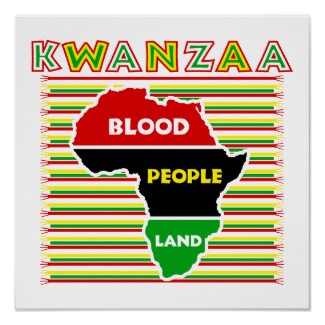Kwanzaa

KWANZAA, the African-American cultural holiday conceived and developed by Dr. Maulana Ron Karenga, was first celebrated on December 26, 1966. Kwanzaa is traditionally celebrated from December 26 through January 1, with each day focused on Nguzo Saba, or the seven principles. Derived from the Swahili phrase "matunda ya kwanza" which means "first fruits", Kwanzaa is rooted in the first harvest celebrations practiced in various cultures in Africa.
Kwanzaa seeks to enforce a connectedness to African cultural identity, provide a focal point for the gathering of African peoples, and to reflect upon the Nguzo Saba, or the seven principles, that have sustained Africans. Africans of all religious faiths and backgrounds practice Kwanzaa.
Kwanzaa was born out of the whirlwind of social and political changes of the sixties decade. The sixties represent one of many eras during which the African and African-American struggle for freedom and self-identity reached its historical peak, spawning multiple revolutionary movements.
By creating Kwanzaa, Africans sought to rectify the cultural and economic exploitation perpetrated against us during the months of October, November, and December (the Christmas season). During this season, corporate America typically ignored the quality of life concerns of African-Americans, yet encouraged participation in the commercialism of Christmas. Additionally, African-Americans did not observe a holiday that was specific to our needs. A review of the major holidays celebrated in the United States would reveal that not one related specifically to the growth and development of African-Americans. The development of Kwanzaa assumed a reassessment, reclaiming, recommitment, remembrance, retrieval, resumption, resurrection, and rejuvenation of the "Way of Life" principles recognized by African-Americans. These principles have strengthened African-Americans during our worldwide sojourn.
Today, Kwanzaa is recognized by millions throughout the world. It is celebrated often in community settings provided by homes, churches, mosques, temples, community centers, schools, and places of work. Kwanzaa allows us to celebrate the season without shame or fear of embracing our history, our culture, and ourselves.

Introduction
Kwanzaa is a spiritual, festive and joyous celebration of the oneness and goodness of life, which claims no ties with any religion.
The focus of Kwanzaa is centered around the seven principles (Nguzo Saba) with particular emphasis on the unity of our Black families. It is a time for gathering of our families, and for a rededication to manifesting the principles of Kwanzaa (Nguzo Saba) as a way of life for Blacks.
Kwanzaa has definite principles, practices and symbols which are geared to the social and spiritual needs of African-Americans. The reinforcing gestures are designed to strengthen our collective self-concept as a people, honor our past, critically evaluate our present and commit ourselves to a fuller, more productive future.
Kwanzaa is a way of life; not just a celebration. As a living social practice, it is a week of actual remembering, reassessing, recommitting, rewarding and rejoicing. For evaluation of ourselves and our history, we relate to our past, reassess our thoughts and practices, and recommit ourselves to the achievement of Black liberation and the betterment of life for all Black Americans.
Finally, the concept of Kwanzaa, the African(-American) holiday, is to help Black people relate to the past in order to understand the present and deal with the future.
Why Celebrate Kwanzaa?
Whenever new information is presented to an individual or a group of people, the information must be accurate, clear and have a specific meaning for that particular individual or particular group. Therefore, the information should be presented in a specific format and should include certain factors. These factors are:
|
|
|
| Focus | Sense of Direction |
|
|
|
| Purpose | Goals |
- The following schedule should be used in preparing your family to participate in the Kwanzaa celebration.
- December 12 - Begin to schedule meetings with family members to assign tasks for the Kwanzaa Celebration.
- December 19 - Gather and arrange Kwanzaa symbols and any other decorations. Arrange the symbols on a low table or on the floor.
- Spread the Mkeka (Straw Mat).
- Place the Kinara (Candle Holder) in the center of the Mkeka.
- Place the Muhindi (Ears of Corn) on either side of the Mkeka. One ear of corn for each child in the family.
- Creatively place the Zawadi (Gifts), Kikombe Cha Umoja (Unity Cup); Tambiko (Water and Soil), and a basket of Mazao fruit on the Mkeka.
- Hang up a Bendera Ya Taifa (Flag of the Black Nation). It should be facing the East.
- Place Mishumaa Saba (Seven Candles) in the Kinara. Remember the Mishumaa should be red, black and green. Use any creative match you desire.
Examples - Three Red; Three Green; One Black; Two Red; Two Green; Three Black
- Begin using the greeting "Habari Gani" and the response "Nzuri Kwanzaa, Nguzo Saba". Note, the response changes on the first day of Kwanzaa to Umoja, on the second day to Kujichagulia, etc.
- A week of fasting, from sunrise to sunset, to cleanse the body, discipline the mind and uplift the spirit is suggested.
Seven Days of Kwanzaa Celebration
Since Kwanzaa is a relatively new holiday, you and your family can use great creativity in you observance of the holiday. Set up an area in your home for the Kwanzaa altar or table. Decorate your home in the same spirit as other holidays. Create posters and banners to hang on the walls, add African sculptures or other artwork. Crafts and decorations can be created to be used in your Kwanzaa display.
Each of the seven days of Kwanzaa represents a different principle of the Nguzo Saba (Seven Principles). When a new candle is lit each day it represents one of these principles.
Many families give the honor of lighting the candles to the youngest child. Some to the eldest family member. Others might have a different family member lighting the candles each night.
The First Day of Kwanzaa (December 26)
On the first day of Kwanzaa the black candle is lit in the Kinara. The black candle represents the first principle - Umoja (oo-MOH-jah): Unity. The person who lights the candle might make a statement about the first principle and its meaning. Sometimes a passage or poem is read relating to what the principle means and how it relates to their life.
Then the Umoja (Unity Cup) might be filled with fruit juice and shared among those gathered. Each takes a drink and passes to the next.
Some families prefer to use a Unity cup for each member, or the cup can just be left in the center of the Kwanzaa table.
After the sharing of the Unity cup the candles are extinguished till the next day.
The Second Day of Kwanzaa (December 27)
On the second day the black candle is again lit, as well as the farthest red candle on the left. This represents the 2nd principle of Kwanzaa - Kujichagulia (koo-jee-chah-goo-LEE-ah): Self-Determination.
Again a statement about the second principle and its meaning might be made. Or possibly a passage or poem is spoken or read which relates to what the principle means and how it relates to their life. The family shares the Unity cup and the candles are extinguished.
The Third Day of Kwanzaa (December 28)
On the third day the black candle is lit, then the farthest left red, and then the farthest right green candle. This represents the 3rd principle of Kwanzaa - Ujima (oo-JEE-mah): Collective work and responsibility.
The third principle is discussed. The family shares the Unity cup and the candles are extinguished.
The Fourth Day of Kwanzaa (December 29)
On the fourth day the black candle is lit, then the farthest left red, the farthest right green. And then the next red candle on the left. This represents the 4th principle of Kwanzaa - Ujamaa (oo-jah-MAH): Collective economics.
The fourth principle is discussed. The family shares the Unity cup and the candles are extinguished.
The Fifth Day of Kwanzaa (December 30)
On the fifth day the black candle is lit, then the farthest left red, the farthest right green, the next red and then the next green candle. This represents the 5th principle of Kwanzaa - Nia (NEE-ah): Purpose.
The fifth principle is discussed. The family shares the Unity cup and the candles are extinguished.
The Sixth Day of Kwanzaa (December 31)
On the sixth day the black candle is lit, then the farthest left red, the farthest right green, the next red, the next green and then the final red candle. This represents the 6th principle of Kwanzaa - Kuumba (koo-OOM-bah): Creativity.
The sixth day, which occurs on New Years Eve, is a special day. This is the day of the Kwanzaa Karamu or Kwanzaa Feast. In the spirit of celebration many families invite their friends and family to join in the festivities.
Create a party atmosphere with additional Kwanzaa decorations. Dress up in traditional or traditional inspired clothing. Play African or African American music. Cook your favorite foods and special holiday dishes. Invite your guests to contribute to the feast by bringing along their favorite dishes. The children and/or the Adults can perform plays, read uplifting passages, poems or stories. Maybe one of the adults will be a story teller for the day. Remember the principle of the day is Kuumba (creativity). So be creative!!
On this special day we remember our ancestors when the Unity cup is shared. After everyone has taken a drink the candles are extinguished.
But before the Karamu is over, the eldest member of those present will read the Tamshi La Tutaonana (TAM-shi la Tu-ta-u-NA-na). The Tamshi La Tutaonana was written by Dr. Karenga, the creator of Kwanzaa, as a farewell statement to the feast and the year.
Everyone stands as the elder reads:
Strive for discipline, dedication, and achievement in all you do. Dare struggle and sacrifice and gain the strength that comes from this. Build where you are and dare leave a legacy that will last as long as the sun shines and the water flows. Practice daily Umoja, Kujichagulia, Ujima, Ujamaa, Nia, Kuumba, and Imani. And may the wisdom of the ancestors always walk with us. May the year's end meet us laughing, and stronger. May our children honor us by following our example in love and struggle. And at the end of next year, may we sit together again, in larger numbers, with greater achievement and closer to liberation and a higher level of life.
Then the elder leads the guests in the Harambee (ha-RAM-bee) salute. Each person raises their right fist about as high as their shoulder, then pulls down forcefully until the elbow is next to next to their torso, saying "Harambee!" This is done seven times in unison.
This concludes the Karamu celebration.
The Seventh Day of Kwanzaa (January 1)
On the seventh day the black candle is lit, then the farthest left red, the farthest right green, the next red candle, the next green, the final red and then the final green candle. This represents the 7th principle of Kwanzaa - Imani (ee-MAH-nee): Faith.
The seventh principle is discussed. The family shares the Unity cup and all seven candles are extinguished. Kwanzaa is over.
Since Kwanzaa is a relatively new holiday, you and your family can use your creativity and imagination when deciding how to celebrate the holiday. Over time you and your family will establish your own traditions that can be enjoyed each year as well as passed on to the next generations.
The Seven Principles of Kwanzaa

The foundation of Kwanzaa are the Seven Principles, or Nguzo Saba. When Dr. Karenga created the celebration of Kwanzaa he wanted to reflect the best qualities and characteristics of the "first fruit" or harvest festivals that were celebrated throughout Africa. It was these qualities that established the Nguzo Saba, or Seven Principles of Kwanzaa. (Nguzo Saba is Kiswahili for Seven Principles).
The Seven Principles (Nguzo Saba) of Kwanzaa are:
- Umoja (oo-MOH-jah): Unity
Success starts with Unity. Unity of family, community, nation and race; To strive for and maintain unity in the family, community, nation and race.
- Kujichagulia (koo-jee-chah-goo-LEE-ah): Self-Determination
To be responsible for ourselves. To create your own destiny; To define ourselves, name ourselves, create for ourselves and speak for ourselves.
- Ujima (oo-JEE-mah): Collective work and responsibility
To build and maintain your community together. To work together to help one another within your community; To build and maintain our community together and to make our brothers' and sisters' problems our problems and to solve them together.
- Ujamaa (oo-jah-MAH): Collective economics
To build, maintain, and support our own stores, establishments, and businesses; To build and maintain our own stores, shops and other businesses and to profit together from them
- Nia (NEE-ah): Purpose
To restore African American people to their traditional greatness. To be responsible to Those Who Came Before (our ancestors) and to Those Who Will Follow (our descendants); To make as our collective vocation the building and developing of our community in order to restore our people to their traditional greatness
- Kuumba (koo-OOM-bah): Creativity
Using creativity and imagination to make your communities better than what you inherited; To do always as much as we can, in the way that we can, in order to leave our community more beautiful and beneficial than when we inherited it.
- Imani (ee-MAH-nee): Faith
Believing in our people, our families, our educators, our leaders, and the righteousness of the African American struggle; To believe with all our hearts in our parents, our teachers, our leaders, our people and the righteousness and victory of our struggle.
Primary Symbols of Kwanzaa
- MKEKA (M-kay-cah)
The Mkeka is a straw mat on which all the other items are placed. It is a traditional item and therefore symbolizes tradition as the foundation on which all else rests. - KINARA (Kee-nah-rah)
The Kinara is a candle-holder which holds seven candles and represents the original stalk from which we all sprang. For it is traditionally said that the First-Born is like a stalk of corn which produces corn, which in turn becomes stalk, which reproduces in the same manner so that there is no ending to us. - MSHUMAA (Mee-shoo-maah)
The seven candles represent the Seven Principles (Nguzo Saba) on which the First-Born sat up our society in order that our people would get the maximum from it. They are Umoja (Unity); Kujichagulia (Self-Determination); Ujima (Collective Work and Responsibility); Ujamaa (Cooperative Economics); Nia (Purpose); Kuumba (Creativity), and Imani (Faith). - MUHINDI (Moo-heen-dee)
The ear of corn represents the offspring or product (the children) of the stalk (the father of the house). It signifies the ability or potential of the offsprings, themselves, to become stalks (parents), and thus produce their offspring -- a process which goes on indefinitely, and insures the immortality of the Nation. To illustrate this, we use as many ears of corn as we have children which again signifies the number of potential stalks (parents). Every house has at least one ear of corn; for there is always the potential even if it has not yet been realized. - KIKOMBE CHA UMOJA (Kee-coam-bay chah-oo-moe-jah)
The Unity Cup symbolizes the first principle of Kwanzaa. It is used to pour the libation for our ancestors; and each member of the immediate family or extended family drinks from it in a reinforcing gesture of honor, praise, collective work and commitment to continue the struggle began by our ancestors. - ZAWADI (Sah-wah-dee)
The presents (gifts) represent 1) the fruits of the labor of the parents, and 2) the rewards of the seeds sown by the children. Parents must commit their children to goodness which to us is beauty. We must commit them to good acts, good thoughts, good grades, etc., for the coming year and reward them according to how well they live up to their commitments. Goodness, again, is beauty and beauty is that which promises happiness to the family and community. For all acts, thoughts and values are invalid if they do not in some way benefit the community. - KARAMU
The feast symbolizes the high festive celebration that brings the community together to exchange and to give thanks to the Creator for their accomplishments during the year. It is held on the night of December 31 and includes food, drink, music, dance, conversation, laughter and ceremony.
Secondary Symbols of Kwanzaa
- NGUZO SABA (En-GOO-zoh Sah-BAH)
Symbolizes the seven principles of Kwanzaa which were developed by Maulana Ron Karenga. The Nguzo Saba are social principles dealing with ways for us to relate to each other and rebuild our lives in our own images. - BENDERA YA TAIFA
The flag of Black Nationalism symbolizes the struggle of Liberation. The Red represents the blood of our ancestors; Black is for the collective color of all Black people, and Green reminds us of the land, life and new ideas we must continue to strive to obtain. - TAMBIKO
Symbolizes the libation by which honor is given in a special way to our ancestors and a call to carry out the struggle and the work they began. It clearly symbolizes the recognition of and respect for the contributions of those before us, our history and the models it offers us to emulate. - HARAMBEE
Symbolizes a call to unity and collective work and struggle. The word means Let's pull together! - HABARI GANI
What's the news; what's happening Swahili term used when greeting others. - KWAHERI
Swahili term used as an expression of parting with good wishes and an expectancy to meet again.

© 2014 Majority NOT Minority Ltd - All rights reserved.
No republication of this material, in any form or medium, is permitted without express permission of the author